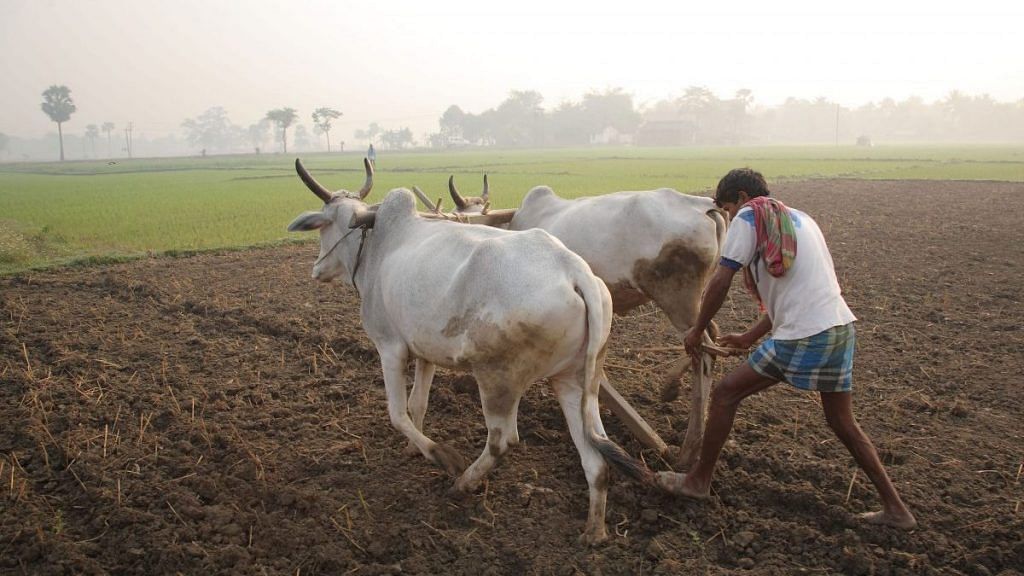There is no doubt that agricultural credit is a critical element of both agricultural production and marketing across India. However, during a period of acute crisis, the government needs to bank on channels that are relatively robust and far-reaching. Unfortunately, especially when it comes to small and marginal farmers, the current channel of choice—the formal system for agricultural credit in India—falls well short.
The second set of announcements unveiled by finance minister Nirmala Sitharaman Thursday under the Narendra Modi government’s atmanirbhar Bharat push focused on directing food and financial assistance to migrants, small farmers, small vendors, and the self-employed. At this critical juncture in the agricultural season, the focus on small and marginal farmers should be welcomed. But we are now operating within a brave new economic vision and rationale, where laws act as the fourth factor of production and loans are the primary lifeline against widespread distress and declining demand. So, those who cultivate the land, and labour for a living, must now put their faith in credit.
Also read: India’s rural economy is facing its biggest challenge, and the pain is only getting worse
Low coverage means limited access to credit
Let us consider the two measures that the government has announced.
The first is the sanction of Rs 30,000 crore additional emergency working capital funding for farmers through the National Bank for Agriculture and Rural Development (Nabard) to be targeted at rural co-operative banks and regional rural banks. However, we know that priority sector lending to small and marginal farmers —the focus of this relief package—is very limited. In its 2019 report, the Reserve Bank’s Internal Working Group to Review Agricultural Credit estimated that despite numerous existing initiatives, at most, only 40 per cent of India’s small and marginal farmers are covered by formal credit.
Across most states, and especially in eastern India (Bihar, Odisha and West Bengal), the share of the number of accounts held by small and marginal farmers is also disproportionately low when compared to their actual numbers. Moreover, as the report notes, these estimates are based on landholding-based data that exclude landless farmers—tenant farmers, oral lessees, sharecroppers—who are a significant proportion of farmers in many regions and remain systemically excluded from the existing formal agricultural credit network. Small and marginal farmers and landless cultivators continue to be largely dependent on informal sources of rural credit. So, it is quite a stretch to assume that this same banking system will now effectively transmit this additional infusion of credit to nearly 3 crore small and marginal farmers in the upcoming season.
Also read: Why Punjab’s farmers are dumping water-guzzling paddy for cash-crop cotton
KCCs too have limited coverage
The second major announcement is Rs 2 lakh crore concessional credit boost to 2.5 crore farmers through Kisan Credit Cards (KCCs). But once again, the record of coverage under KCCs, a scheme first introduced in 1998, over 20 years ago, should concern us. The RBI’s Internal Working Group estimated that as of 2019, only around 45 per cent of all Indian farmers possessed an operative KCC and that given the existence of multiple accounts per farmer, the percentage is likely to be even lower. Indeed, Nabard’s own NAFIS Survey 2016-17, reported that only 10.5 per cent of agricultural households were found to have a valid KCC.
Instead of utilising the PM-KISAN platform to further front-end and disburse cash transfers (it is after all a DBT scheme), the database is now to be used to extend coverage of credit under KCCs. But the PM-KISAN database has itself had trouble with the identification of farmers and also only includes landowning farmers, leaving out landless farmers, tenant farmers and sharecroppers.
In addition, now livestock farmers and fishermen are also to be covered by KCCs, while the method for their identification is unclear. More generally, livestock and allied activities remain woefully uncovered by formal agricultural credit, of which 90 per cent goes towards crop loans. Once again, while the intention to include livestock and fisheries in this new infusion of working capital is laudable, given that they are currently almost completely out of the purview of existing channels makes it difficult to comprehend how this can count as relief.
Also read: Karnataka govt announces Rs 162 cr relief package for weavers, vegetable & fruit growers
Emergency measures need different approach
It would be one thing if these announcements were made as part of a routine Budget speech. Even then, we would be at pains to stress the importance of actual institutional capacity and inclusive systems of delivery. But adding the word ‘emergency’ to such measures simply will not do the trick on the ground.
Agrarian and rural distress was intensifying long before the lockdown. Farmers and agricultural labourers now face an extremely challenging and uncertain season of cultivation ahead. They are going to rely most immediately on the existing formal and largely informal systems and networks for agricultural credit, production and marketing, wherever they are.
Central and state governments should use existing channels to ensure cash (through PM-KISAN and other means) and work under MGNREGS are widely available, and extend the financial and institutional support that these systems need to be truly demand driven.
Most importantly, they need to urgently put in the preparation and coordination required to ensure that all agricultural inputs, especially seeds, are in circulation and accessible to farmers in the weeks ahead, when they need it the most. Farmers are past masters at understanding the importance of time and timing in economic life. The government, as ever, has much to learn from them.
Shoumitro Chatterjee is an Assistant Professor of Economics at the Pennsylvania State University. Mekhala Krishnamurthy is Senior Fellow and Director of the State Capacity Initiative at the Centre for Policy Research and Associate Professor at Ashoka University.
